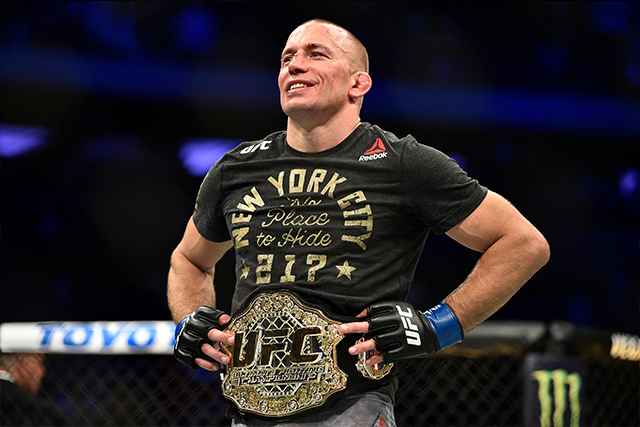Solving Stalling in 5 Easy Steps

Boring is a part of sports. No way around it. Basketball is constantly interrupted by referees. Boxers can put on their running shoes. Baseball -- well, baseball was obviously engineered to be boring. It’s the cruelest joke ever perpetuated on humanity. Even when you have complete control over the pace of something -- like the WWE’s ballet of groin shots -- you can still stink up the place. It’s impossible to completely supercharge anything. Unless someone is on fire.
The idea instead is mitigation. Keep the mind-numbing to a minimum. In this, Japan should be considered a pioneer: at a time when American promotions were still allowing endless time in an ineffectual guard or clinch, referees there would do everything short of batons and tazers to provoke action. (Give it time.) Inactive? They’ll take 10 percent of your purse. Stalling? More money taken away, or maybe your plane ticket home.
Thanks in part to late notice and spectacular mismatches, leagues like Pride had a pretty high good-to-blah work rate. Unfortunately, they also treated fighters like cattle. Kazushi Sakuraba, a 15-year veteran of such tactics, moves like he’s walking through wet cement. This is too much. But it’s possible to promote more exciting fights without compromising health or safety. Here’s how.
The referee needs a quicker trigger. How many times have we spent minutes staring half-lidded with fighters in the clinch, jockeying for position that isn’t going to come? Eventually, the referee comes in to break them up, but it’s often too late: the crowd is lost. Significantly shorten the duration given to fighters who are tied up against the fence to 15 or 20 seconds. Could it conceivably affect the outcome of the fight? It could -- but so can three rounds instead of five or 10, along with the other thousand variables that keep this an approximation of a fight, not a 59-round John L. Sullivan homage.
Start subtracting instead of only adding. The MMA judge’s mindset is to reward aggression and damage with 10 points in the round. In the midst of multi-level action, it’s an easy equation to remember. But deducting points is every bit their obligation, as well. Why should a fighter who barely lost a competitive round be afforded the same score (of nine) as a guy who got his nose busted, his arm tendons torqued, and his rear-end planted, especially if both scenes play out in the same fight? Losers are supposed to get “nine or less.” Less is more.
Punish passivity, aka “the staring contest.” Confident he had won the first two rounds, Maiquel Jose Falcao Goncalves did virtually nothing in the third against Gerald Harris Saturday. Why risk getting into trouble when the fight is in the bag? It’s the same principle that cost Oscar De La Hoya his infamous fight against Felix Trinidad years ago. In the rules, the referee can deduct a point for passivity. If he had, Falcao would have been looking at a 10-8 round, and a 28-28 draw.
Shrink the cage. The UFC has done everything within ethical reason to encourage action: bonuses for finishing, locker-room checks for exciting fights, and punishing boring fighters by delaying title shots. It’s all fine, but the problem is that those reprisals are delayed: in the fight, the fighter is mostly concerned with protecting his neck and winning. Forcing action needs to begin as soon as the bell rings.
The UFC’s official Octagon is 30’ in diameter; it shrinks only for Ultimate Fight Night events or Spike’s “The Ultimate Fighter.” That’s a lot of space to gallop around like a show pony. In contrast, the WEC’s cage is (was) 25’. Fighters have no place to move but directly into one another.
There’s a nice pageantry surrounding a big, enclosed fence, and the UFC has rarely showed any interest in changing it. But fighters are now adept in evasive maneuvering, playing for the cards, and avoiding exchanges. You can’t turn it into a phone booth, but you don’t need a football field, either.
Stuff the gloves. The No. 1 reason fighters are sometimes reluctant to charge in: getting hit with five-ounce gloves absolutely sucks. There’s virtually nothing to prevent bone meeting bone and transmitting horrible, nauseating force. A lightly-padded MMA mitt is treated like it was wrapped in glass shards. Fighters are wary of taking even one shot.
Getting a few more ounces into the gloves without compromising grappling or gripping would dull that effect by a decent amount; blows would become less severe and the fighter would be emboldened to come forward and create more opportunities to land a combination or a good shot that finishes it.
Granted, there’s ongoing debate about whether bigger gloves even protect heads; they might instead be better cushioning for the hand to deliver a more potent blow. But a bowling ball dropped on your skull is going to hurt whether it’s wrapped in padding or not. And because of the grappling element, MMA fighters will never sustain the volume of head strikes boxers do.
More reasons?
Bigger gloves: fewer cut stoppages.
Bigger gloves: fewer hand injuries. Fighters fight more frequently.
Blow up the gloves and see if the fighters don’t feel more confident in eating less damaging shots to deliver their own. As the sport evolves, it becomes necessary to make sure the trappings evolve with it.






